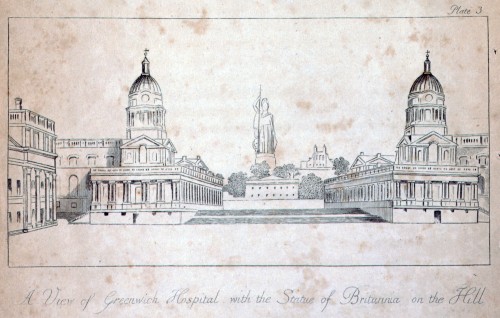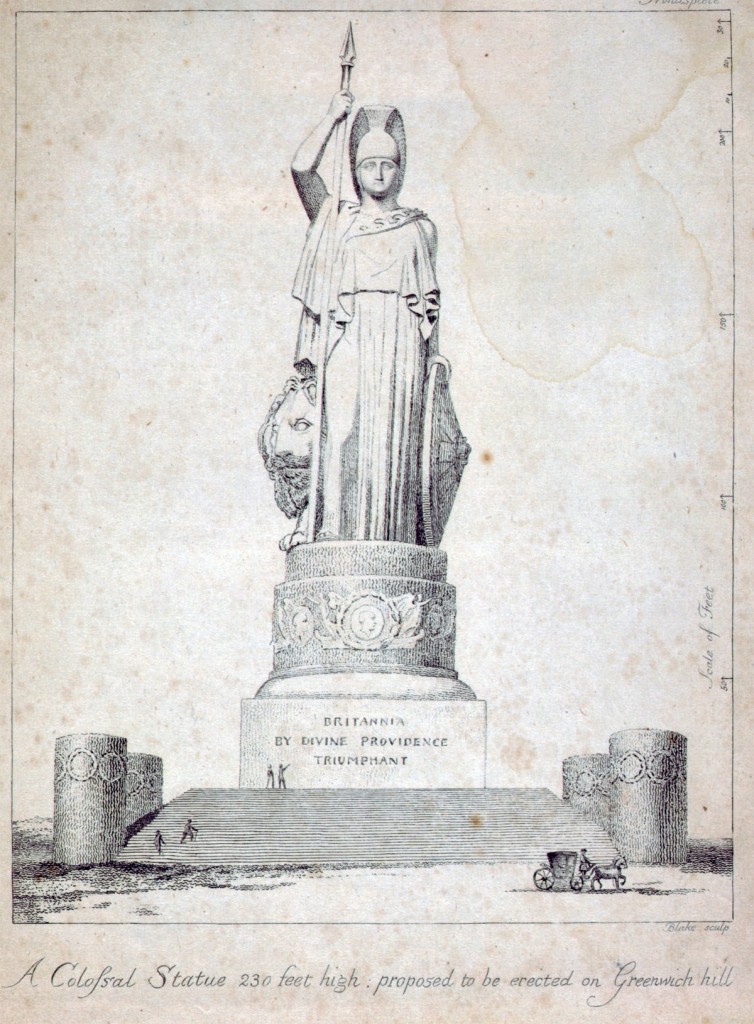Greenwich could today be less famous for its observatory and meridian, than for a gigantic statue which would have dominated the area.
Planned as a celebration of the British victory at the Battle of the Nile, Britannia Triumphant would have been a 230 feet tall statue at the very top of Greenwich hill. The statue’s full title, Britannia By Divine Providence Triumphant was a clear indication of Britain’s God-given right to be the dominant power in Europe, and later the world.
The proposal for the statue was a response to calls for a monument, which was set up by a government committee that was calling for a “Naval Pillar” to be erected. It was drawn up by John Flaxman, a noted draughtsman, although the drawing which appeared on the front of a booklet promoting the statue appears to have been by his pupil, William Blake.
“If it is greatly conceived, and executed in a manner worthy of the grandeur and power of the country, it will ensure the praise and admiration of succeeding ages.” he wrote in his submission.
Flaxman’s submission was made in 1799, summarised in the St James’s Chronicle in January 1800, and he also showed off a model in 1801, which is now in Sir John Soane’s museum.
He added that as “Greenwich Hill is the place from whence the longitude is taken, the Monument would, like the first Mile-Stone in the city of Rome, be the point from which the world would be measured”.
The choice of Greenwich for the world’s meridian point was opposed by the French in the later International Meridian Conference, and how much stronger would their objection have been had the point been also marked by a statue to their defeat? The statue was also opposed by those who feared its bulk would overwhelm the existing buildings at the foot of the hill.
Another critic accused him of wishing to “hew Greenwich Hill into a woman large enough to graze a couple of goats in her lap”, while another said there is to be “a show at Greenwich of little Flaxman and big Britannia”.
The satirist, James Gillray published a scathing cartoon decrying the entire concept of a monument, showing a Naval Pillar with Britannia atop the dead bodies of the defeated French.
The statue was also criticized by the Critical Review who noted its lack of naval accompaniments, which they felt seemed odd for a monument to a naval victory.
Although never built (obviously!), as the battle being commemorated was won by Nelson, the design appeared in versions on The Trafalgar Vase, and the Nelson Monument in St Paul’s Cathedral.
Part of the reason it wasn’t built is that Flaxman himself withdrew his submission, arguing that a rival plan by John Opie, for a Gallery of British Honour. In the end, the committee studying the plans also went for John Opie’s design – but it was also not built. However, its ideas indirectly increased support for public access to art — later to be manifested in the National Gallery.
A slightly later scheme, by Thomas Tagg and Richard Elsam for an actual pillar at the top of Greenwich, didn’t get any traction. Today, Greenwich Hill does sport a statue, a much smaller one than planned, and of a different warrior — General Wolfe.
Sources:
Madam Britannia: Women, Church, and Nation 1712-1812 by Emma Major
St James’s Chronicle, 18-20 January 1800
Sir John Soane Museum, M1079
The Saturday Magazine, Volume 18, July to December 1840
National Portrait Gallery, Design for the naval pillar
Victoria and Albert Museum, The Trafalgar Vase
The Naval Chronicle, Volume 3
National Maritime Museum, Naval Pillar (PAD3896)
The Critical Review. Volume 31
US Library of Congress, Six alternative versions of a monument









That statue looks rather sinister and I can imagine lethal laser beams erupting from the eyes. It reminds me of ‘Gort’.